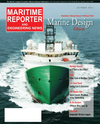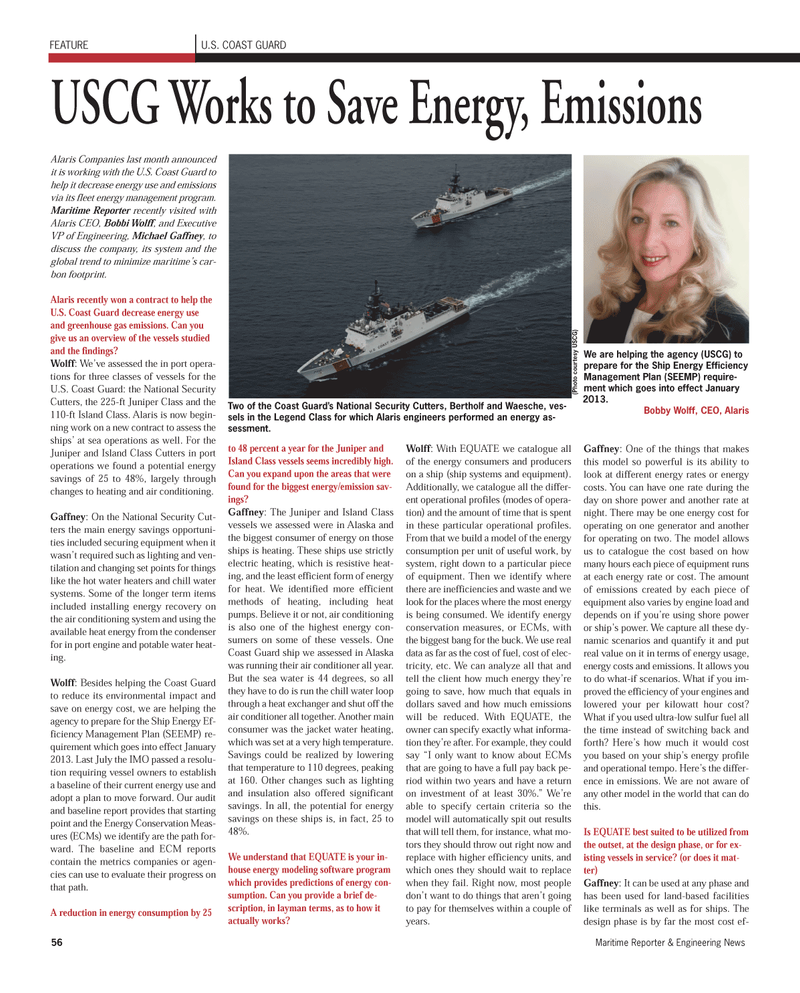
Page 56: of Maritime Reporter Magazine (October 2011)
Marine Design Annual
Read this page in Pdf, Flash or Html5 edition of October 2011 Maritime Reporter Magazine
Alaris Companies last month announcedit is working with the U.S. Coast Guard to help it decrease energy use and emissions via its fleet energy management program. Maritime Reporterrecently visited with Alaris CEO, Bobbi Wolff , and ExecutiveVP of Engineering, Michael Gaffney , todiscuss the company, its system and the global trend to minimize maritime?s car- bon footprint.Alaris recently won a contract to help the U.S. Coast Guard decrease energy use and greenhouse gas emissions. Can you give us an overview of the vessels studied and the findings? Wolff : We?ve assessed the in port opera- tions for three classes of vessels for the U.S. Coast Guard: the National SecurityCutters, the 225-ft Juniper Class and the110-ft Island Class. Alaris is now begin- ning work on a new contract to assess the ships? at sea operations as well. For the Juniper and Island Class Cutters in portoperations we found a potential energy savings of 25 to 48%, largely through changes to heating and air conditioning.Gaffney: On the National Security Cut-ters the main energy savings opportuni- ties included securing equipment when itwasn?t required such as lighting and ven- tilation and changing set points for thingslike the hot water heaters and chill water systems. Some of the longer term itemsincluded installing energy recovery on the air conditioning system and using theavailable heat energy from the condenser for in port engine and potable water heat- ing.Wolff : Besides helping the Coast Guardto reduce its environmental impact and save on energy cost, we are helping the agency to prepare for the Ship Energy Ef- ficiency Management Plan (SEEMP) re- quirement which goes into effect January 2013. Last July the IMO passed a resolu-tion requiring vessel owners to establish a baseline of their current energy use and adopt a plan to move forward. Our audit and baseline report provides that starting point and the Energy Conservation Meas- ures (ECMs) we identify are the path for- ward. The baseline and ECM reports contain the metrics companies or agen-cies can use to evaluate their progress on that path. A reduction in energy consumption by 25 to 48 percent a year for the Juniper and Island Class vessels seems incredibly high. Can you expand upon the areas that were found for the biggest energy/emission sav- ings?Gaffney: The Juniper and Island Class vessels we assessed were in Alaska and the biggest consumer of energy on those ships is heating. These ships use strictly electric heating, which is resistive heat- ing, and the least efficient form of energy for heat. We identified more efficient methods of heating, including heatpumps. Believe it or not, air conditioning is also one of the highest energy con- sumers on some of these vessels. One Coast Guard ship we assessed in Alaska was running their air conditioner all year. But the sea water is 44 degrees, so all they have to do is run the chill water loop through a heat exchanger and shut off the air conditioner all together. Another main consumer was the jacket water heating, which was set at a very high temperature. Savings could be realized by lowering that temperature to 110 degrees, peaking at 160. Other changes such as lightingand insulation also offered significant savings. In all, the potential for energy savings on these ships is, in fact, 25 to 48%.We understand that EQUATE is your in- house energy modeling software program which provides predictions of energy con- sumption. Can you provide a brief de- scription, in layman terms, as to how it actually works? Wolff : With EQUATE we catalogue all of the energy consumers and producers on a ship (ship systems and equipment).Additionally, we catalogue all the differ- ent operational profiles (modes of opera- tion) and the amount of time that is spentin these particular operational profiles. From that we build a model of the energy consumption per unit of useful work, by system, right down to a particular piece of equipment. Then we identify where there are inefficiencies and waste and we look for the places where the most energy is being consumed. We identify energy conservation measures, or ECMs, with the biggest bang for the buck. We use real data as far as the cost of fuel, cost of elec- tricity, etc. We can analyze all that and tell the client how much energy they?re going to save, how much that equals in dollars saved and how much emissions will be reduced. With EQUATE, the owner can specify exactly what informa- tion they?re after. For example, they could say ?I only want to know about ECMs that are going to have a full pay back pe- riod within two years and have a return on investment of at least 30%.? We?re able to specify certain criteria so themodel will automatically spit out resultsthat will tell them, for instance, what mo-tors they should throw out right now and replace with higher efficiency units, and which ones they should wait to replace when they fail. Right now, most people don?t want to do things that aren?t going to pay for themselves within a couple of years.Gaffney: One of the things that makes this model so powerful is its ability to look at different energy rates or energy costs. You can have one rate during the day on shore power and another rate at night. There may be one energy cost for operating on one generator and anotherfor operating on two. The model allows us to catalogue the cost based on how many hours each piece of equipment runs at each energy rate or cost. The amount of emissions created by each piece ofequipment also varies by engine load and depends on if you?re using shore power or ship?s power. We capture all these dy- namic scenarios and quantify it and putreal value on it in terms of energy usage, energy costs and emissions. It allows you to do what-if scenarios. What if you im- proved the efficiency of your engines and lowered your per kilowatt hour cost? What if you used ultra-low sulfur fuel all the time instead of switching back andforth? Here?s how much it would cost you based on your ship?s energy profile and operational tempo. Here?s the differ- ence in emissions. We are not aware of any other model in the world that can do this.Is EQUATE best suited to be utilized from the outset, at the design phase, or for ex- isting vessels in service? (or does it mat- ter)Gaffney: It can be used at any phase and has been used for land-based facilities like terminals as well as for ships. The design phase is by far the most cost ef- FEATURE U.S. COAST GUARD56Maritime Reporter & Engineering News USCG Works to Save Energy, Emissions We are helping the agency (USCG) to prepare for the Ship Energy Efficiency Management Plan (SEEMP) require- ment which goes into effect January 2013. Bobby Wolff, CEO, Alaris Two of the Coast Guard?s National Security Cutters, Bertholf and Waesche, ves- sels in the Legend Class for which Alaris engineers performed an energy as- sessment. (Photo courtesy USCG) MR Oct.11 # 7 (50-56):MR Template 10/5/2011 3:30 PM Page 56

 55
55

 57
57
